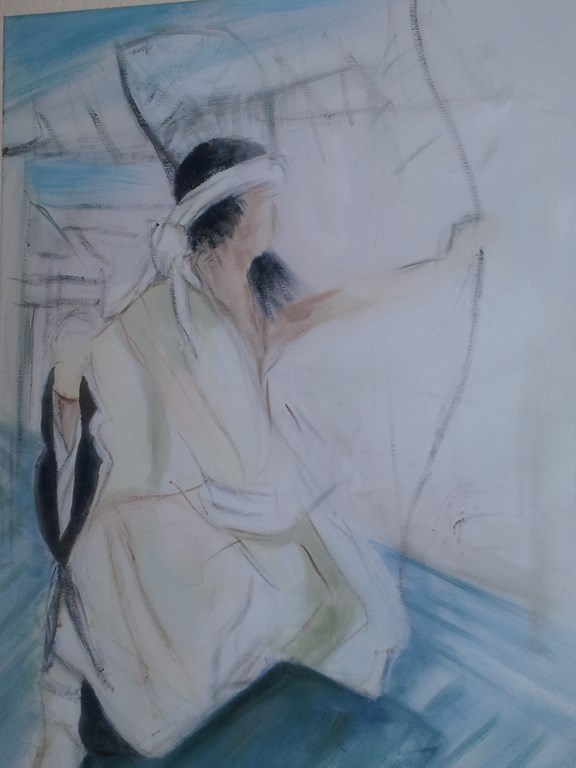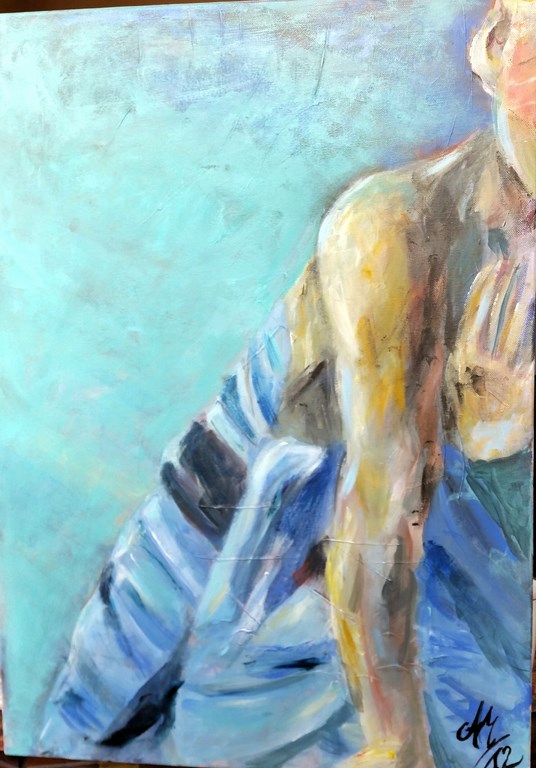Dr. Saskia Schottelius has released her latest book in the TAO-Verlag ”Do – the way to the inner master: Martial arts philosophy for life.” It is published by Chikara Women in Motion eV and is provided with beautiful illustrations by Antje Meister.
On 20.11.2015 from 19:00 Dr. Saskia Schottelius is invited to a book presentation / reading at 3 treasures . In advance, I conducted an interview with her.
“Be free wherever you are” or “Move your body and live a mindful mind!”
3 treasures : Dear Saskia, I am glad that you have your new book ”Do – the way to the inner master: Martial arts philosophy for life“ here to present at 3 treasures and that we have the opportunity for this interview.
Before we talk about the book, what does CHIKARA mean?
Saskia Schottelius : Dear Patrick, I am also very happy and thank you for this wonderful opportunity to present my work and my thoughts. “Chikara” means “inner strength,” “life energy,” and is the name of the martial arts school I started over 20 years ago. You can also read it as a combination of Tai Chi and Kara te, and at the same time meet the core of our work: the connection of Far Eastern energy work and Japanese martial arts.

3 treasures : You write that your new book is addressed to all those who want to find themselves about Far Eastern movement and their Buddhist philosophy and to grow beyond themselves. At the same time it is about very practical techniques and basic ideas in a women’s martial arts school. Tell us a bit about your connection of these two ways, so martial arts and meditation or Buddhist philosophy.
Saskia Schottelius: In the introduction to my book, there is a small stylistic knowledge of Shuri-ryu karate and how it came from Okinawa via the US and the Netherlands to Bonn. On its way, it took the “feminist turn”, meaning that women have taken this style to give their own interests such as “defensiveness” and “visibility”. Seen from this point of view, the school that inspired the “women’s struggle” of the 1970s has become a women’s martial arts school. It focuses on strengthening the personality of women, children and adolescents so that they can assert themselves peacefully in life. The spirit of this school is different from that of martial arts schools, which focus on topics such as “competition”, “aggression reduction” or “hardening”. The feminine side of art is a holistically invigorating, motivating and peaceable one, as I find expressed in the work of Thich Nhat Hanh, among others. That’s why it was so important to me to write a book about women’s martial arts before it disappears from view or disappears completely.
3 treasures : Please explain “Dokan, the way is a circle” and the importance of “beginner spirit” in karate.
Saskia Schottelius : The Enso, the calligraphy circle on the cover of my book, points to the philosophy of “Dokan”: the way is a circle. That fascinated me the most at the beginning of my karate career – it was in direct opposition to my (straight-forward) career as a scientist I was chasing after – or rather chasing ahead! That made me successful, but not relaxed and satisfied. In the martial arts world, I experienced something different. Again and again, I stood at the very beginning with what I had learned – no matter how much I moved and tried. But gradually I understood. A new belt color makes no salary increase – so it is useless from the point of view of our society. The meaning is only in your own development of lightness, generosity, humility, serenity and patience, but not in a measurable value. And when you realize that the real learning eventually begins with the black belt, you come very close to the idea of the “perfect” cycle.
In my book, there are many Asian anecdotes, which bring the wonderful to the point: “Empty your cup” against our “always-already-know” or the story of the fisherman, that became famous as “anecdote for lowering the work ethic” by Heinrich Böll, or the parable of "wearing a black belt" instead of “being a black belt” – they all and many more show us a good way away from success thinking.
“Change your language and you change your world!”
3 treasures : A chapter in your book also deals with mindful communication. You have studied communication research and phonetics and also offer rhetoric seminars. From a karate dojo you may know a more one-sided and also hierarchical communication, in the form of commands etc. What is the language of your dojo at CHIKARA?
Saskia Schottelius : Yes, the language. This is of course my very personal passion. In the course of my life, I have become increasingly aware of how essential language is to us, and how important it is to adress oneself and others in a positive, supportive language. And we can really “serve” ourselves: the language offers many beautiful possibilities, without us using euphemisms. It always depends mainly on the perspective. Do I name my strengths or my weaknesses? What I name will gain space and dominate me in my life. I also have this experience in my work as a freelance lecturer everywhere: whether with policewomen, doctoral candidates or politicians – all are aware of their deficits. And the whole thing is reinforced by the many old patterns in which we think and live and which are conserved by language in the form of phrases and proverbs. Double negations instead of praise, misfortune and embarrassment are drummed in from an early age: “not of bad parents”, “who digs a pit …”, “self-stinks”, etc. Only when we start to speak another language can we free ourselves from this power.
In fact, we can practice another language well in the dojo. That’s what we do with “Chikara”. At the end of the lesson, in meditation, we think of a motivational mantra (“I’m beautiful, I’m strong, I can do that”) and we cherish ourselves and each other in the final round instead of reprimanding for our bad conditioning / coordination or anything else. Small steps, big impact.
A lot of very practical exercises can be found in the book. And mindful language in the dojo also means quite concretely that the teachers speak gender-sensitive language. Because in a male dominated language structure women can only become visible in an explicit naming.
![]()
And with that we are in the even wider concept of “body – language in motion” …
3 treasures : what exactly is meant by that?
Saskia Schottelius : Our postures reveal a great deal about what moves us in life. In my seminars and courses, there are always units such as the Qigong Taoist health exercises, through which I experience a great deal of my participants.
Of course, that’s a big advantage, especially if we’re working on convincing self-expression. When I change my postures, I often change the mind that has solidified behind it. So a fatigue, an excessive demand, a great restraint, all this and much more often appears as raised shoulders, advanced heads or round backs. Many women and children make the first step out of a victim role by changing their postures.
If we go one dimension further, we come to such daring as well as plausible theses that information can be transmitted through water, body and language are the messengers of human existence, and certain patterns of movements reflect universal structures. Also of these ominous things is my book. What is important to me is always the connection of philosophy and practice: What good is this insight or idea for my everyday life and how can I implement what I learn in the dojo.
3 Treasures : Your understanding of seeing the dojo as a place of relationship, of encounter rather than competition, even as an image of the entire cosmos, is very much in line with how we see the exercise in a Zen dojo. How important is the form, the rules in such a community for you?
Saskia Schottelius : Dojo etiquette is an integral part of a way art. By bowing down to treat objects with respect, dress uni-form (that is, appear without status symbols), and essentially silence, we practice “real mindfulness,” the central premise and practice of all path arts.

And there are so many beautiful paths next to zazen and martial arts, such as Chado, the tea path, Shodo or Calligraphy, the path of the brush, Ikebana, the art of flower sticking or Kyudo, the way of the bow. It is always about “breathing” perfect attention in the very moment – and that means freedom in the end: freedom of plans, annoyances, purposefulness, greed, of being-willing and being-should, of own and foreign expectations etc.
Once we have experienced that the balance of the cosmos can get much better and regulate by not intervening, we are effectively spared a lot of stress. We just need to keep our mind open and let things just come. The mechanisms of “wuwei,” action by inaction, have their own laws. And if, as in the dojo, I learn to follow my intuition, I can connect with them much better.
3 treasures : What role do you have as a sensei in this system?

Saskia Schottelius : Yes, of course, I practice just like everyone else in a dojo, a place of the way. Sensei literally means “only” the one who precedes the way, so nothing better, but just longer on the way. The biggest challenge for me is actually not to intervene. When conflicts arise in me or show up in others, I practice “wise restraint”. The fighter in me, who likes to go to the barricades, wants something different. Of course I find that difficult.
Perhaps the most obvious example is violence. My life experience is that you have to answer violence and force it to the greatest extent, including physical violence, so that it does not receive total power. But I do not want to use force. Meanwhile, I think it best to shrink the negative as much as possible by giving the positive so much space that it gains influence and dimension.
Resilient people, those with special inner adaptability, help themselves in dangerous situations with the art of directing the mind – as in a dojo. With every kiai, the battle cry or breath at the height of an action, and every kata, form of combat against imaginary opponents, we connect with a power that reaches far beyond ourselves. This is not just chi energy, it is also the power of positive transformation.

 way to the inner master: Martial arts philosophy for life.
way to the inner master: Martial arts philosophy for life.